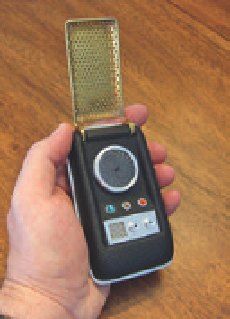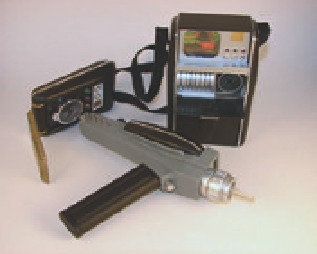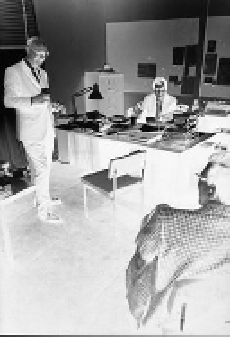Information Technology Reference
In-Depth Information
Perhaps the most iconic image of computers from the 1960s was that of the
HAL 9000 (
Fig. 17.5
) computer in Stanley Kubrick's 1968 movie
2001: A Space Odyssey
.
Kubrick cowrote the screenplay with the science fiction writer Arthur C. Clarke
(
B.17.10
) and the movie was based on Clarke's short story “The Sentinel.” Contrary
to the widespread belief that the computer was called HAL because it was a one-let-
ter shift from the initials IBM, Kubrick and Clarke always insisted that HAL stood
for Heuristically programmed ALgorithmic computer. In the movie, HAL was built
in 1992 at the University of Illinois, Urbana - where a real-life early parallel super-
computer called the ILLIAC-4 had been designed. In addition to monitoring and
controlling every aspect of the Discovery One spaceship, HAL was sentient and able
to perform complex tasks such as speech processing, speech recognition, natural
language processing, lip-reading, and facial recognition, as well as playing games
like chess. In the movie, with the Discovery on the way to Jupiter, HAL appears to
be mistaken in reporting a fault with the ship's communication antenna. In order
that HAL cannot overhear, the two astronauts, Dave Bowman and Frank Poole, get
into an Evacuation Vehicle on board the ship so that they can discuss what to do
about HAL's unreliability. By a very large extrapolation of the lip-reading capabili-
ties of present-day computers - using only a side view of the lips and not a face-on
view - HAL is able to “hear” that they are considering disconnecting him. HAL then
plans to kill the astronauts and succeeds in killing Poole and three other unfortu-
nate crew members still in cryogenic hibernation. Bowman manages to survive
and grimly sets about disconnecting all of HAL's processor modules.
Why did HAL malfunction? The reason is only hinted at in the original
movie but is made clearer in the 1984 sequel
2010: Odyssey Two
. When HAL's cre-
ator is able to examine the computer he concludes that the crisis was caused by
a programming contradiction. HAL was constructed for the accurate processing
of information without distortion or concealment but this goal was in conflict
with HAL's orders to keep the real reason for the mission secret. HAL's decision
to kill the crew was the computer's logical way of resolving the conflict.
The prediction that a sentient computer would exist by 2001 has obviously
not been fulfilled but another computer technology in the movie recently made
the headlines. In response to Apple's lawsuit against Samsung's tablet comput-
ers, the company cited a YouTube video from Kubrick's movie as constituting
relevant prior art:
Fig. 17.3. The
Star Trek
communica-
tor device looks similar to some early
mobile phones.
Fig. 17.4. A
Star Trek
tricorder and other
devices from the
Star Trek
TV series.
B.17.10. Arthur C. Clarke (1917-2008) (standing) was a prolific inventor and science fiction writer.
His early work on radar led him to the idea of communication satellites. The man behind the desk
is the film director Stanley Kubrick. The third person in the photograph is Victor Lyndon, who was
associate producer of
2001: A Space Odyssey
and also worked on
Dr. Strangelove
. The photo was most
likely taken around 1964-5, in the early stages of
Space Odyssey
.



Search WWH ::

Custom Search